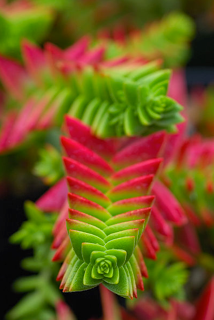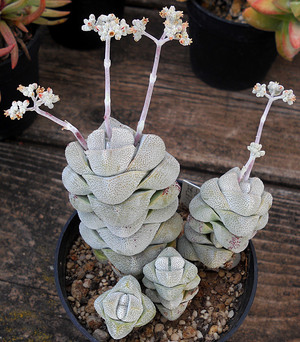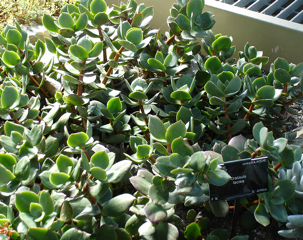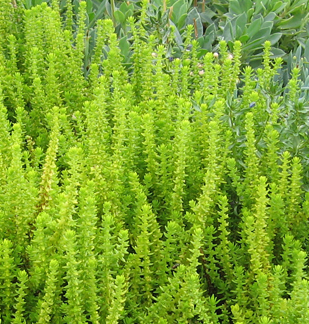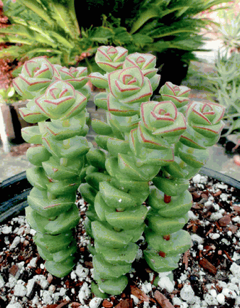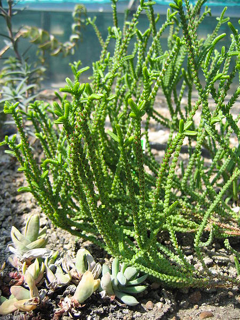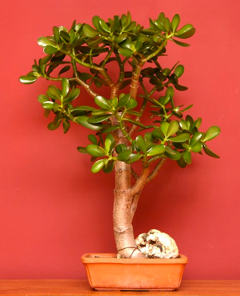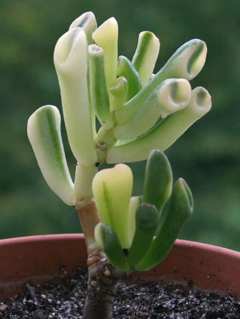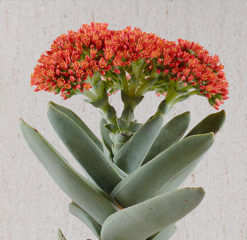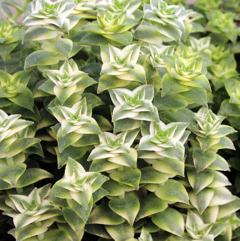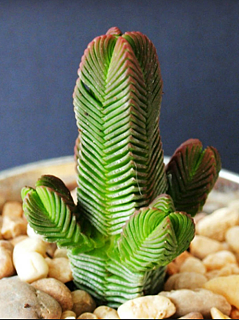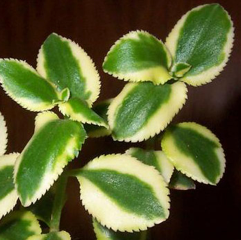Submitted by: Jim Tanner
Crassula is the largest genus in the family [Ed: Crassulaceae], containing everything from bog plants to some of the most extreme succulents. Many Crassula species have been naturalized and are commonly seen as garden plants in Southern California. These include C. arborescens, C. falcata, C. perforata. Many hybrids and cultivars are available, offering a large variety of colors and shapes. One of the best is Morgan’s Beauty. Some favorite species include: Crassula arta [Ed: synonym for Crassula deceptor] which makes columns of close packed triangular leaves. As the stem lengthen with age, cuttings can be taken and the plant restarted. Crassula lycopodioides is a wonderful plant for hanging baskets. Its thin green strands of tiny leaves offset from roots and the base to fill a good size pot. Crassula pyramidalis forms mats of short four sided stems.
Many Crassulas border on being weedy. They get lanky after a year or two, and the bottom leaves either fall off or turn brown. Cuttings of these plants should be taken (they almost always root), and the plants restarted either in the early fall (October is best) or early spring (late February to April). Great things can be done in a small space with this genus.
Tom Glavich
[Ed: Crassula is a major genus of the Crassulaceae family and members are known for their amazing ability to perform CAM (Crassulacean Acid Metabolism). CAM in simple terms is the ability to perform photosynthesis during the daytime using Carbon Dioxide (CO2) that has been collected and stored at night. As the plants are not intaking CO2 during the heat of the day, they are able to keep their stomata (pores) closed thereby greatly reducing the loss of liquid. The CO2 collected at night is stored in the form of acid malate and is converted back to CO2 internally during the day when photosynthesis is taking place. see Wikipedia]
LATIN LOOKUP – Loquerisne Latine (Do you speak Latin)?
The meanings of latin plant names on this page – from http://davesgarden.com/guides/botanary/
- arborescens [ar-bo-RES-senz]
Tree-like. - capitella [kap-ih-TEL-uh]
With small head. - Crassula [KRASS-oo-la, KRASS-uh-la]
Somewhat thickened foliage; diminutive of the Latin crassus (thick, fleshy). - falcata [fal-KAY-tuh]
Sickle-shaped. - lactea [lak-TAY-uh]
Milky. - lycopodioides [ly-kop-oh-dee-OY-dees]
Resembling Lycopodium (from the Greek lukos, wolf; and podion, foot). - marnieriana [mar-nee-air-ee-AH-nuh]
Named for Anne Therese Marnier-Lapostolle, first wife of Julien Marnier-Lapostolle; 20th century owner of famous plant collection. - muscosa [muss-KOH-suh]
Mossy. - ovata [oh-VAY-tuh]
Ovate in shape. - perfoliata [per-foh-lee-AY-tuh, per-foh-lee-AH-tuh]
Leaf surrounding a stem. - perforata [per-for-AY-tuh]
Perforated, punctured. - pyramidalis [peer-uh-mid-AH-liss]
Pyramid-shaped. - sarmentosa [sar-men-TOH-suh]
Producing a runner. - variegata [var-ee-GAY-tuh]
Variegated.

